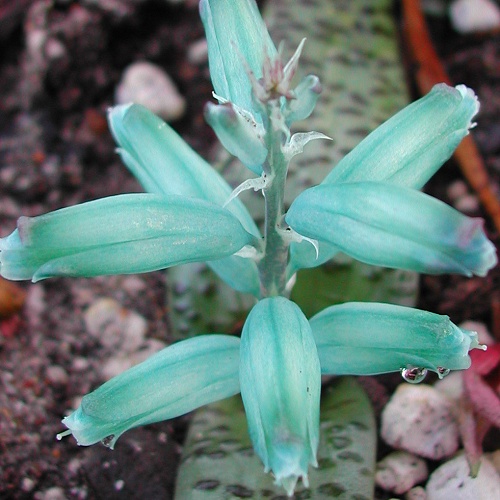"Turquoise Hyacinth"
Planting the bulbs
When to plant -- Your bulbs will sprout in autumn, so mark your calendar to plant them in mid- to late-October (April in the Southern Hemisphere). Until then, store them in a paper bag in a cool spot. Or you may plant them in soil before autumn, if the soil can be kept almost completely dry until autumn. Either way, store them out of direct sunlight. Note that they may sprout in autumn even if not in soil, so don't wait too long to plant them. Pot size -- Use a pot at least 4 inches tall (15 cm), and wide enough so each bulb is at least 1 inch (2.5 cm) from the next one, and from the edge of the pot. Use a pot with drainage holes. If you live in a warm-winter area like the tropics, use a larger, clay pot, to keep the roots cooler. Soil -- Use a fast draining soil mix. A typical mix is 1 part
quality potting soil Planting the bulb -- The top of the bulb usually is pointier than the bottom, which is flatter and may have dried roots. If you can't tell which end is the top, just plant them sideways and they will straighten themselves out as they grow. Bury them so the top of the bulb is about ½ inch (1-2 cm) deep. In mid-October, water the soil lightly until it is slightly moist (not saturated), and keep it this moist until they sprout. Until they sprout, keep them between about 48 and 74 degrees F (9-24 degrees C). They should begin sprouting within 1 to 4 weeks of watering them. Once they sprout, move them to a sunny spot or the equivalent artificial light (See: "Growing indoors with LED lights"). Full sun is best throughout winter in most locations, but if you are in the tropics, they might need some afternoon shade to keep cool. Watering -- Keep the soil evenly moist throughout the growing season. Avoid letting it dry out completely, but also
don't keep it constantly saturated or the bulbs might rot. If you're unsure if the soil has the proper
moisture in the root zone, use a
moisture meter Climate -- Throughout winter, it likes temperatures between about 48 and 72 degrees F (9-22 degrees C). Warmer temperatures in winter may make the plants lanky and the flower color might not be as intense. Indoors, you can keep them on the floor of a cooler room. Outdoors, keep them from freezing. Lighting -- They prefer mostly sunny conditions throughout winter & spring. Some afternoon shade may be needed in warmer, lower latitudes such as Florida, while full sun is best in the higher latitudes. Or keep them 2 inches (5 cm) away from a bright LED light (See: "Growing indoors with LED lights"). Feeding -- This bulb has relatively low fertilizer requirements. Feed about a week after they sprout, and again 2-3 months later. Use an all-purpose fertilizer that contains micronutrients. They have shallow roots, so feed near the bulbs. Avoid feeding after March. Dormancy care -- In spring, the bulbs will begin to die back to prepare for their summer dormancy. Reduce watering during this time, giving just enough water to keep the soil from drying out completely. Once the leaves have died back, you may remove the bulbs and store them in a paper bag in a cool spot until autumn.. or just leave them in their pot. Every 2-3 years, they should be separated and planted into new soil. Pests to watch for -- Mealy bugs might grow on the bulbs indoors - look for cottony growth on the leaves near the soil, which means the bugs are on the bulb. Try using an insecticidal soap soil drench to kill mealy bugs. Have fun growing them! - Jeff Strange Wonderful Things
|
|||||||||


